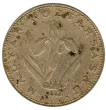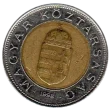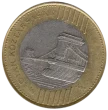Exchange your Hungarian Forints
Do you have leftover Hungarian Forints? We offer a fast and easy way to exchange both current and withdrawn Hungarian Forint banknotes and coins. Convert them into your local currency today with our quick and hassle-free exchange service.
Ft - HUF
The Hungarian Forint has been in use since 1946 and remains a key part of Hungary’s financial system.
Hungarian Forints Information
The Hungarian Forint (HUF) is the official currency of Hungary, a country located in Central Europe. The Forint was introduced in 1946, replacing the Hungarian pengő, which had suffered from hyperinflation following World War II. The introduction of the Forint was part of Hungary’s post-war economic recovery and marked a significant step in stabilising the country’s economy after years of turmoil. Since its introduction, the Forint has undergone several changes but remains a key part of Hungary’s economy.
The Forint is subdivided into 100 fillér, although fillér coins are no longer in circulation. Hungarian coins are minted in 5, 10, 20, 50, 100, and 200 forints, while banknotes are issued in denominations of 500, 1,000, 2,000, 5,000, 10,000, and 20,000 forints. The designs on Hungarian Forint banknotes often feature portraits of important historical figures, such as kings, politicians, and cultural icons, as well as depictions of famous Hungarian landmarks, including castles and bridges.
The Hungarian Forint was initially introduced as a stable currency to combat hyperinflation and restore confidence in the Hungarian economy. In the years following its introduction, the Forint helped Hungary rebuild its economy, particularly in the post-war recovery and the challenges of transitioning from a socialist system to a market economy. Hungary’s economic reforms in the 1990s further strengthened the Forint, enabling the country to attract foreign investment and participate more a…
Despite the stability provided by the Forint, the currency has faced challenges in recent years, particularly due to fluctuations in global markets and the impact of the COVID-19 pandemic. Hungary’s reliance on exports, particularly in sectors such as automotive manufacturing and electronics, means that the Forint is sensitive to changes in global demand. Additionally, Hungary’s close economic ties to the European Union have influenced the performance of the Forint, as the currency often fluctuates.
The National Bank of Hungary (MNB) is responsible for issuing the Hungarian Forint and managing the country’s monetary policy. The central bank plays a crucial role in maintaining price stability and ensuring that inflation remains within manageable levels. In recent years, the MNB has taken steps to modernise Hungary’s financial system and improve the stability of the Forint. Hungary is a member of the European Union but has not yet adopted the Euro, choosing instead to retain the Forint as its national currency.
In recent years, Hungary’s economy has continued to grow, and the Forint remains a central part of the country’s financial system. Although there has been ongoing debate about whether Hungary should eventually adopt the Euro, the Forint remains widely used and trusted for both domestic transactions and international trade. As Hungary continues to develop its economy, the Forint will likely remain a key part of its financial landscape for years to come.
In conclusion, the Hungarian Forint has been the official currency of Hungary since 1946 and remains a stable and trusted currency. It has played a crucial role in Hungary’s post-war recovery and continues to support the country’s economic growth.













